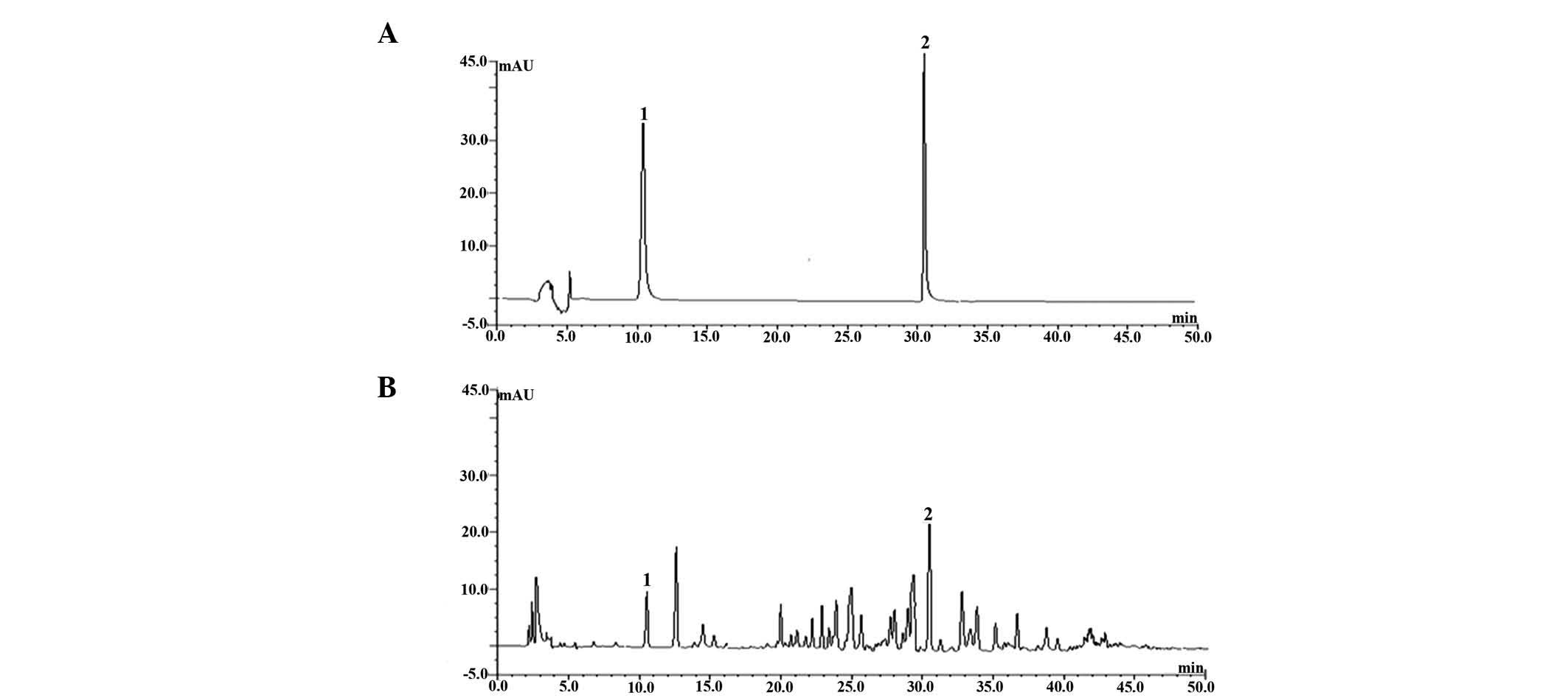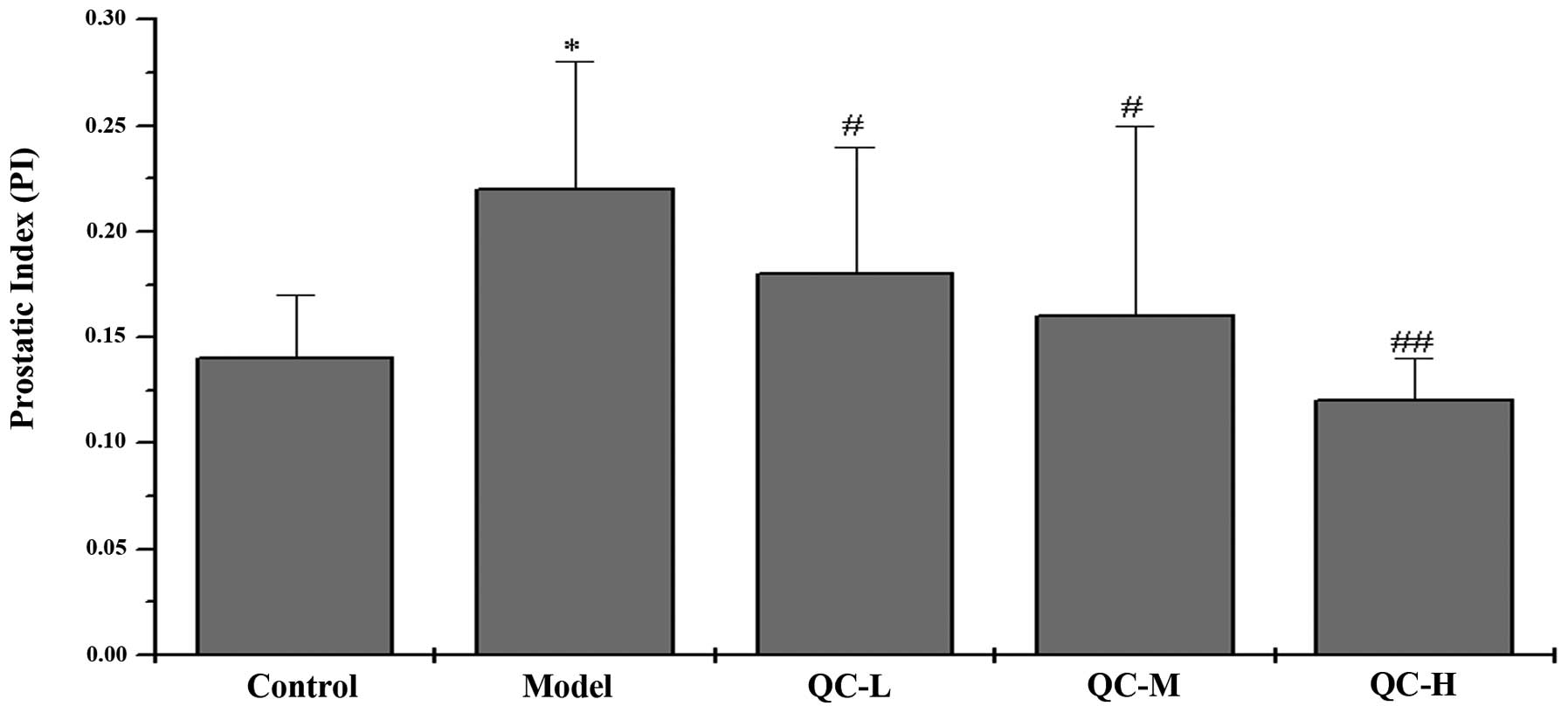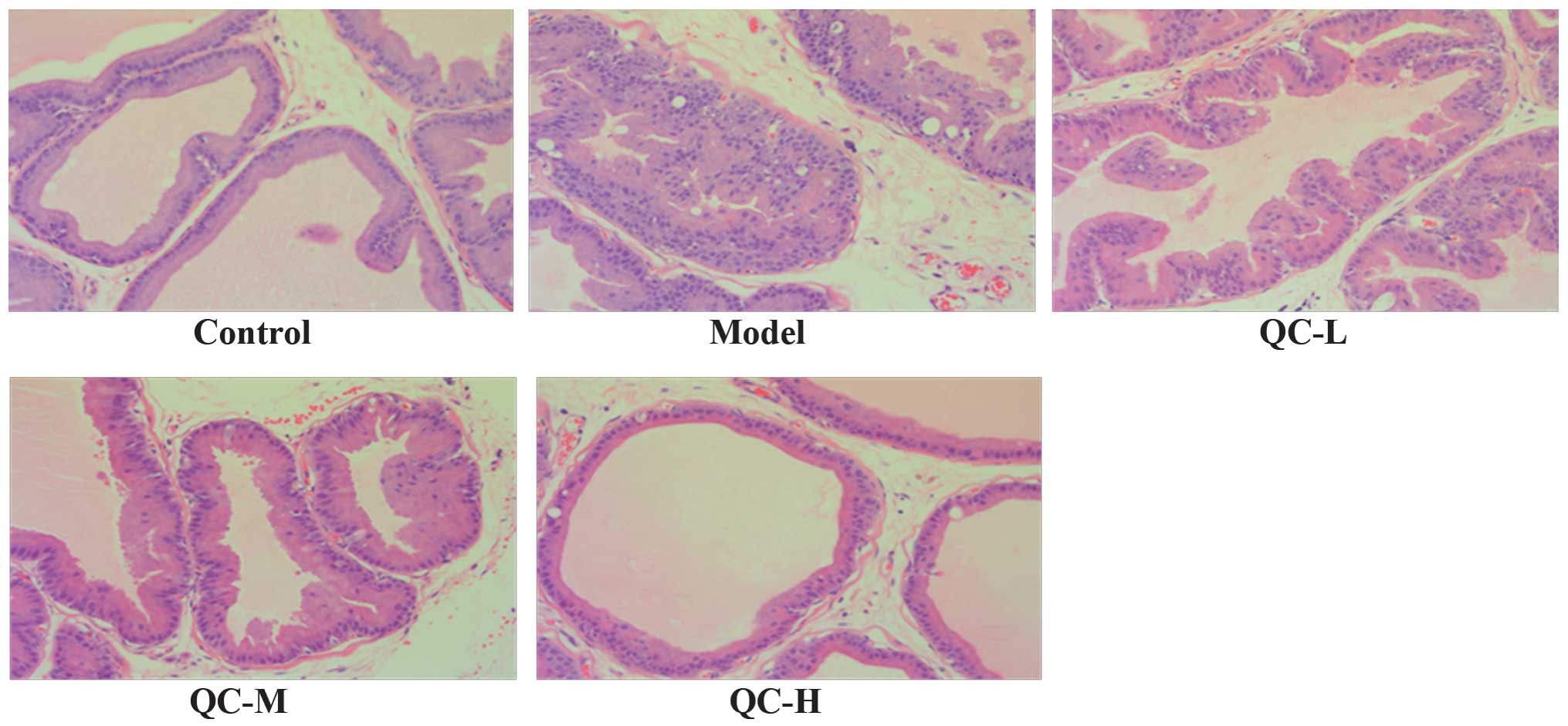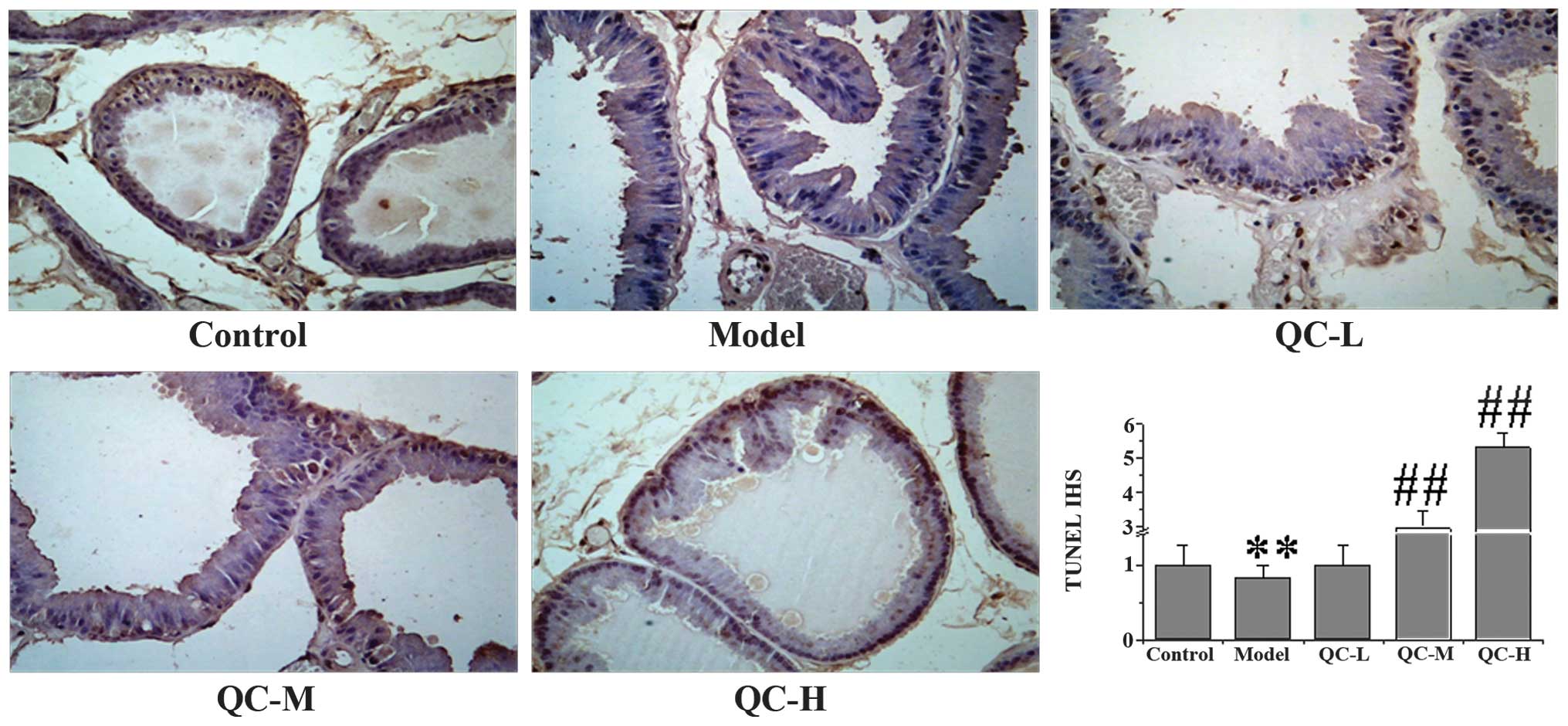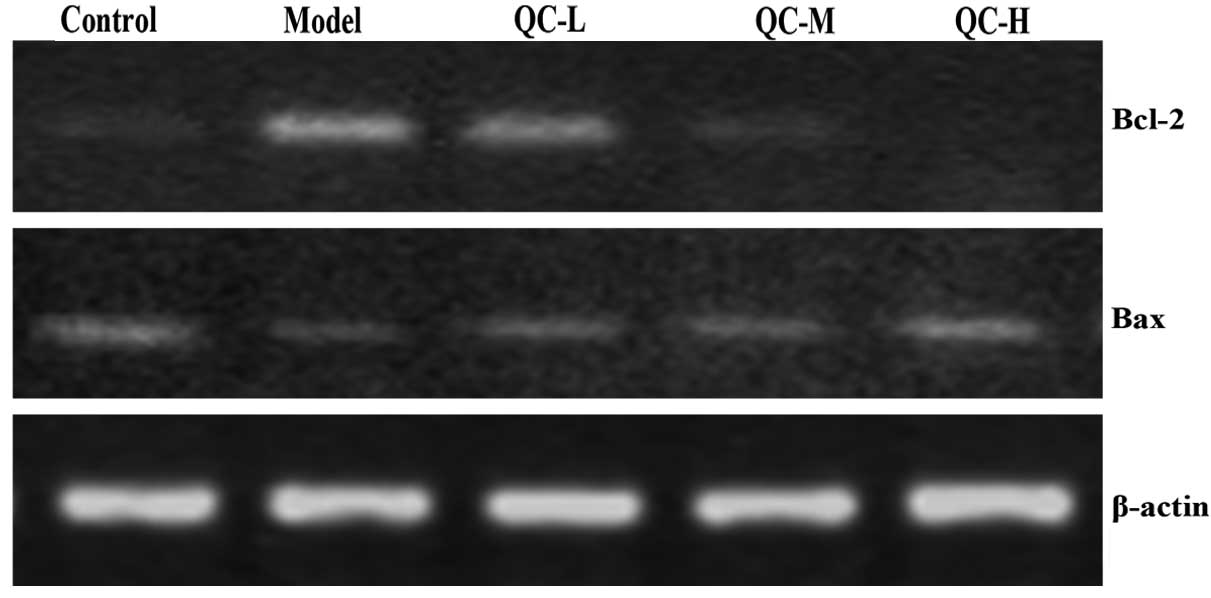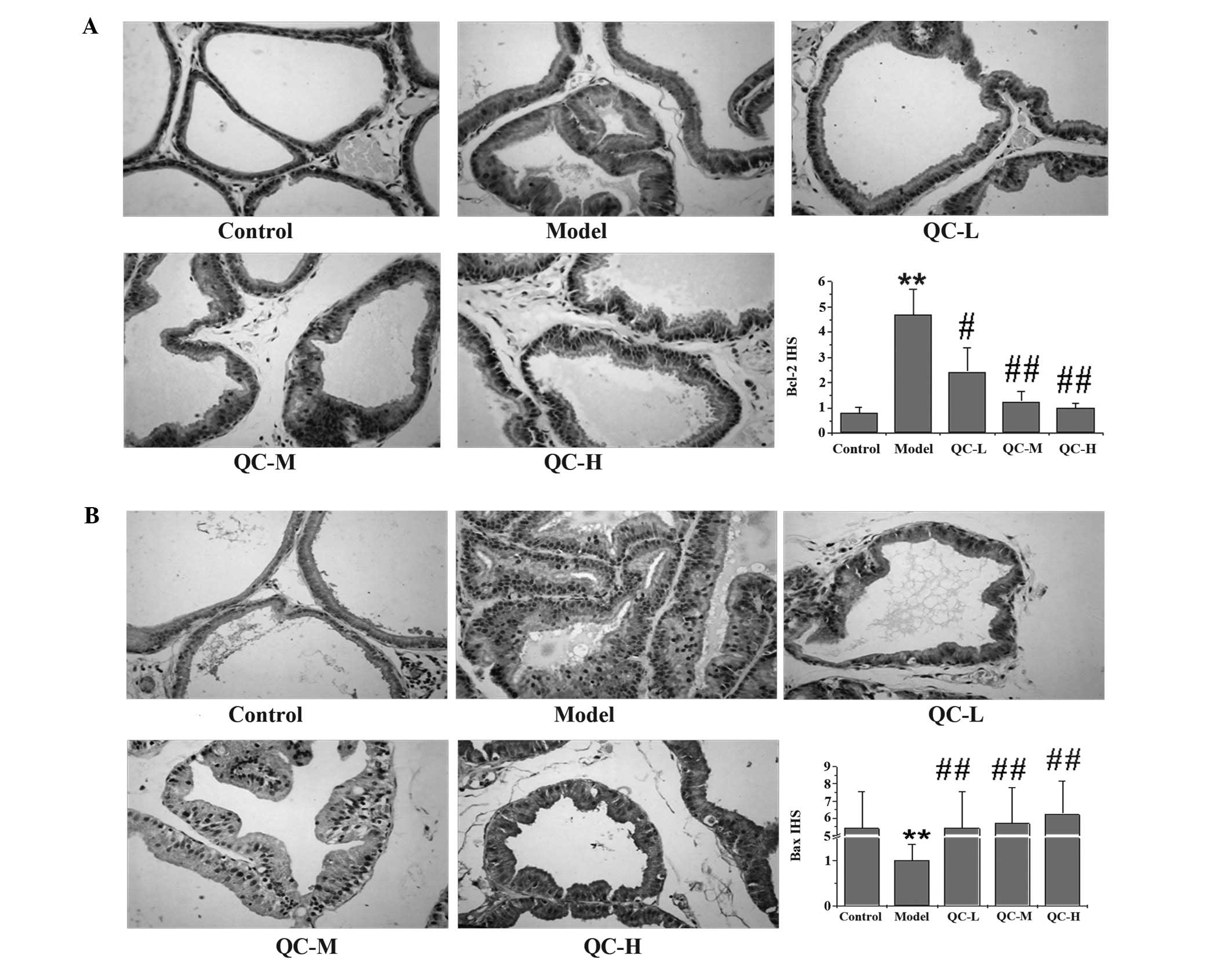Qianliening capsule treats benign prostatic hyperplasia via induction of prostatic cell apoptosis
- Authors:
- Published online on: January 7, 2013 https://doi.org/10.3892/mmr.2013.1265
- Pages: 848-854
Abstract
Introduction
Benign prostatic hyperplasia (BPH) is a non-malignant enlargement of the prostate gland, which results from the progressive hyperplasia of stromal and glandular prostatic cells (1). BPH causes increased resistance to urine flow, leading to lower urinary tract symptoms (LUTS) including urinary hesitancy, frequent urination, urgency, thin urine flow and urinary retention (2), which are known to significantly affect the physical and mental health of patients as well as their quality of life. Delayed treatment results in numerous severe complications, such as bleeding from the prostate, recurrent infections, renal stones and even kidney failure.
Although the pathogenesis of BPH remains unclear, the reduction of cell apoptosis, which leads to the increase in the total number of stromal and epithelial cells, has been strongly associated with the development of BPH (3–6). Mitochondrial-dependent pathway is the most common apoptotic pathway in vertebrate animal cells (7–9). The mitochondrial membrane permeabilization, accompanied by the collapse of electrochemical gradient across the mitochondrial membrane, is one of the key events during cellular apoptosis (10). This results in the release of numerous apoptogenic proteins from the mitochondria triggering the activation of aspartate-directed cysteine proteases (caspases) and eventually inducing apoptosis (11–14). Bcl-2 family proteins are key regulators of mitochondria-mediated apoptosis, including anti-apoptotic members such as Bcl-2 and pro-apoptotic members such as Bax (7–9). Mitochondrial outer membrane permeabilization (MOMP) is thought to occur through the formation of pores in the mitochondria by pro-apoptotic Bax-like proteins (15–17), which could be inhibited by anti-apoptotic Bcl-2-like members (7,11,18,19). The ratio of active anti- and pro-apoptotic Bcl-2 family members determines the fate of cells and alteration of the ratio by aberrant expression of these proteins impairs the normal apoptotic program thereby contributing to various apoptosis-related diseases including BPH (20). Therefore, promoting cell apoptosis has been suggested as a promising strategy for the development of anti-BPH agents.
Pharmacotherapy remains the major approach for BPH treatment. The mainstay of pharmacotherapy includes α-adrenergic blockers and 5α-reductase inhibitors (21,22). α-adrenergic blockers inhibit α-adrenergic receptors, relaxing smooth muscle in the prostate and the bladder neck, thus decreasing the blockage of urine flow. 5α-reductase inhibitors suppress 5α-reductase, inhibiting dihydrotestosterone production and, therefore, enlargement of the prostate. However, α-adrenergic blockers and 5α-reductase inhibitors may have serious side-effects such as orthostatic hypotension, decreased libido and ejaculation or erectile dysfunction (23–27). Due to these risks, natural products that appear to have limited adverse effects have recently received great interest in BPH treatment.
Qianliening capsule (QC) is a traditional Chinese medicine formula composed of Whitmania pigra Whitman, Rheum palmatum L., Achyranthes bidentata and Chinese Dodder. These components together confer QC properties of heat-clearing, detoxification, promotion of blood circulation and removal of blood stasis and tonifying the kidney and nourishing vitality (replenishing the kidney Qi in Chinese) (28,29). QC has been shown to have significant therapeutic effects on BPH, significantly improving a series of LUTS and ameliorating the urodynamic evaluation indices in BPH patients. Previous studies on BPH rats noted that QC was able to significantly reduce the prostatic volume and weight and suppress prostate enlargement (29–31). However, the precise mechanism of its anti-BPH activity remains to be fully elucidated. In the present study, we evaluated the therapeutic efficacy of QC in BPH rats and investigated the underlying molecular mechanism, using a BPH rat model.
Materials and methods
Drugs and reagents
QC was provided by the Academy of Pharmacology of the Fujian University of Traditional Chinese Medicine (FDA approval no. Z09104065; Minhou Shangjie, Fuzhou, Fujian, China). The drug powder inside QC was dissolved in distilled water and stored at 4°C. Testosterone propionate injection solution (25 mg/m1) was obtained from the Shanghai General Pharmaceutical Co., Ltd. (batch no. H31020524; Shanghai, China). TRIzol reagent was purchased from Invitrogen (Carlsbad, CA, USA). SuperScript™ II reverse transcriptase was obtained from Promega (Madison, WI, USA). Bcl-2, Bax and cleaved caspase 3 primary antibody, secondary antibody, streptavidin-peroxidase (SP) and 3,3′-diaminobenzidine (DAB) were purchased from Bohai Biotechnology Development Co., Ltd. (Hebei, China). Terminal deoxynucleotidyl-transferase-mediated X-dUTP nick end-labeling (TUNEL) In situ Cell Death Detection kit was purchased from Roche (cat. no. 1684809; Mannheim, Germany). Additional chemicals, unless otherwise stated, were obtained from Sigma Chemical (St. Louis, MO, USA).
High-pressure liquid chromatography (HPLC) analysis of QC
QC was extracted by ultrasonic-assisted extraction (32). The standard solutions of oleanolic acid and emodin and extracts were filtrated through 0.45-μm microporous membranes prior to being injected into the liquid chromatography. Conditions of HPLC analysis were as follows: the mobile phase was methanol and 0.1% phosphoric acid (70:30, v/v), the flow rate was 1 ml/min, the injection volume was 20 μl, the column temperature was kept at 35°C and the detection wavelengths were set at 208 nm.
The chromatograms of sample and oleanolic acid and emodin standard solutions are shown in Fig. 1. Oleanolic acid and emodin in QC were baseline separated at these conditions and were identified by the retention time with corresponding peaks compared to the standard solution. It was found that QC was true, stable and according to the drug requirements of China.
Animals
Fifty specific pathogen-free (SPF) grade adult male Sprague-Dawley (SD) rats with a body weight of 200–220 g, purchased from Shanghai Si-Lai-Ke Experimental Animal Co. Ltd. (Shanghai, China), were housed under controlled temperature (21–23°C), humidity and a 12-h light/dark cycle, with free access to standard rat chow and tap water.
The animal experiments were conducted in compliance with the International Ethical Guidelines and the National Institutes of Health Guide concerning the Care and Use of Laboratory Animals. The study was approved by the Animal Care and Use Committee of Fujian University of Traditional Chinese Medicine.
Groups and treatment
The BPH rat model was generated by subcutaneous injection of testosterone propionate (5 mg/kg) following castration. The scrota of 40 rats of a total 50 male SD rats were cut open, castrated and then sutured. The remaining ten rats were cut open and then sutured without cutting off the testicles, and were allocated to the sham-operated group. A week after surgery, the 40 castrated rats were randomly divided into four equal groups (n=10). The total experimental rats were assigned into the following five groups: sham-operated group (control), model group (model), and three QC groups [QC-low (QC-L), QC-medium (QC-M), QC-high (QC-H)]. The three QC groups (QC-L, QC-M and QC-H) were intragastrically administered a dose of 2.25, 4.5 and 9 g/kg, respectively. The injection of edible oil was subcutaneously administered to rats of the sham-operated group and testosterone propionate was subcutaneously administered to the castrated rats (5 mg/kg) every day. The sham-operated and model groups were intragastrically administered normal saline (10 ml/kg) every day. The drugs were administered daily for 28 consecutive days.
Sample collection
Twenty-four hours after the last administration, rats were anesthetized with sodium pentobarbital [50 mg/kg intraperitoneally (i.p.)]. Prostate was removed, weighed and the weight index was obtained. Approximately half of the gland tissue of each rat was fixed in 10% formalin solution for histopathological examination and immunohistochemical (IHC) analysis. The remaining half of the glands was plunged into liquid nitrogen and stored at −80°C until total RNA extraction for gene expression analysis.
Histological examination
The fixed prostatic tissue was dehydrated in graded ethanols, embedded in paraffin, sliced in serial 5 μm sections, deparaffinized in xylene, rehydrated in graded ethanol and then stained with hematoxylin and eosin (H&E) for histological observation under a light microscope.
TUNEL staining
TUNEL staining protocol was according to a Roche protocol. Paraffin-embedded sections were dewaxed in xylene and rehydrated in graded ethanol series to water, pemeabilized with 20 μg/ml proteinase K for 15 min at room temperature and then incubated in TUNEL reaction mixture for 60 min at 37°C. The tissue was then rinsed in phosphate-buffered saline (PBS) three times for 5 min and incubated in converter-peroxidase (POD) for 30 min at 37°C, rinsed in PBS three times for 5 min and color-developed with a DAB POD substrate. The last step was to rinse and counterstain with hematoxylin. Cells with brown-stained nuclei in five different fields were counted under a light microscope at a magnification of ×400. Apoptotic index was calculated by multiplying the quantity and staining intensity scores as described in the IHC analysis section.
IHC analysis
SP was employed in Bcl-2, Bax and cleaved caspase 3 IHC analysis. Sections (5 μm) were sliced, deparaffinized, rehydrated, submerged in 1% hydrogen peroxide, epitope retrieved, and then soaked in goat serum, followed by an overnight incubation with primary antibodies at 4°C. Control slides were incubated with PBS without primary antibodies. The slides were then washed in PBS and incubated for 20 min at 37°C with biotinylated secondary antibody. After being rinsed in PBS, the slides were exposed to streptavidin biotin-peroxidase complex for 20 min at 37°C and again rinsed in PBS. The slides were stained with DAB color development solution for 6 min, then rinsed and counterstained with hematoxylin. The IHC slides were examined with a method of immunohistochemical score (IHS), which was calculated by combining an estimate of the percentage of immunoreactive cells (quantity score) with an estimate of the staining intensity (staining intensity score), as follows: no staining, 0; 1–10%, 1; 11–50%, 2; 51–80%, 3 and 81–100%, 4. Staining intensity was rated on a scale of 0–3, with 0, negative; 1, weak; 2, moderate and 3, strong. The raw data were converted to the IHS by multiplying the quantity and staining intensity scores (33).
Total RNA extraction and reverse transcription-polymerase chain reaction (RT-PCR)
Total RNA was extracted according to the TRIzol RNA isolation protocol. The purified total RNA was quantified with a spectrophotometer at wavelengths of 260 and 280 nm. The A260/A280 ratio was <1.6. One microgram of total RNA was reverse transcribed into complementary DNA (cDNA) by using SuperScript™ II transcriptase according to the manufacturer's instructions. The obtained cDNA was amplied by PCR with TaqDNA polymerase (Fermentas, Hanover, MD, USA). β-actin was used as the internal control. cDNA transcripts were amplified using the following primer sequences: Bcl-2: 5′-GG TGG TGG AGG AAC TCT TCA-3′ and 5′-GA GCA GCG TCT TCA GAG ACA-3′; Bax: 5′-CC AAG AAG CTG AGC GAG TGT-3′ and 5′-TC ACG GAG GAA GTC CAG TGT-3′; β-actin: 5′-AC TGG CAT TGT GAT GGA CTC-3′ and 5′-CA GCA CTG TGT TGG CAT AGA-3′. The PCR reaction was performed using the following conditions: for Bcl-2, denaturation at 95°C for 45 sec, annealing at 56°C for 45 sec and extension at 72°C for 60 sec; for Bax, denaturation at 95°C for 45 sec, annealing at 53°C for 45 sec and extension at 72°C for 60 sec; for β-actin, denaturation at 95°C for 45 sec, annealing at 55°C for 45 sec and extension at 72°C for 60 sec. RT-PCR products were analyzed by 1.5% agarose gel electrophoresis. The DNA bands were examined using a Gel Documentation System (Model Gel Doc 2000; BioRad, Hercules, CA, USA). Transcripts were normalized to β-actin transcript levels and the relative mRNA level was indicated as the ratio of the density of the detected genes to β-actin at the same time point.
Statistical analysis
Data were reported as the mean ± standard deviation (SD). Statistical analyses were performed using SPSS 16.0 by one-way ANOVA (analysis of variance) and the Student's t-test. P<0.05 was considered to indicate a statistically significant difference.
Results
QC inhibits prostate growth in BPH rats
The in vivo therapeutic efficacy of QC against BPH was investigated by evaluating its effect on prostatic index (PI), determined by calculating the ratio of prostatic weight to body weight. The mean PI in the model group was significantly elevated compared with that in the control group (P<0.05), indicating a successful model construction (Fig. 2). However, QC treatment significantly reduced PI in BPH rats (P<0.05) in a dose-dependent manner, demonstrating the anti-BPH efficacy of QC in vivo.
QC improves the histological damage of prostate tissue in BPH rats
The prostate histological changes in BPH rats were observed via light microscopy after H&E staining. As shown in Fig. 3, low columnar epithelial cells in the control group were arranged as a single-layer secretory lumen that was filled with thin acidophilic materials, whereas in the model group the epithelial cells clearly proliferated to develop excessive glands and cells were arranged as multiple unorganized layers. However, the prostate histopathological damages in BPH rats were significantly ameliorated by QC treatment in a dose-dependent manner (Fig. 3).
QC induces apoptosis in BPH rats
To determine whether the inhibitory effect of QC on prostate growth was due to cell apoptosis, we examined its effect on cell apoptosis in BPH rats via immunohistochemical staining for TUNEL. Data in Fig. 4 show that QC treatment increased the proportion of TUNEL-positive cells in a dose-dependent manner, compared with the control and model groups, demonstrating a pro-apoptotic activity of QC in vivo. To further evaluate these results, we performed IHS to evaluate the effect of QC on the cleavage of caspase 3, a critical event during apoptosis. As shown in Fig. 5, QC treatment increased the level of cleaved caspase 3 in prostate tissues of BPH rats in a dose-dependent manner. Taken together, it is suggested that the QC-mediated inhibition of prostate growth is accompanied by its pro-apoptotic activity.
QC increases the pro-apoptotic Bax/Bcl-2 ratio in BPH rats
To further explore the mechanism of the pro-apoptotic activity of QC, we examined its effect on Bcl-2 and Bax expression using RT-PCR and IHS. Data from the RT-PCR assay indicated that QC significantly reduced the mRNA expression of anti-apoptotic Bcl-2 in BPH rats, while the expression of pro-apoptotic Bax was significantly increased following QC treatment (Fig. 6). Similarly, results of IHS showed that the protein expression pattern of Bcl-2 and Bax were similar to their respective protein levels (Fig. 7). These data demonstrate that QC promotes prostate cell apoptosis in vivo by increasing the pro-apoptotic Bax/anti-apoptotic Bcl-2 ratio.
Discussion
Treatment options for BPH include surgery and pharmacotherapy. Although surgery is more efficient for elderly patients and those with severe heart, lung and kidney dysfunction, pharmacotherapy remains the most common modality of choice. The two main drugs for the management of BPH are α-adrenergic blockers and 5α-reductase inhibitors, both with their own side-effects. Therefore, herbal remedies are often preferred for the management of BPH since they usually have fewer negative effects and exhibit therapeutic efficacy. As a traditional Chinese medicine formula that has been used in clinical practice, QC has been shown to be effective in the treatment of BPH. However, the mechanism of its anti-BPH activity still remains to be elucidated. Therefore, before QC is further developed in an anti-BPH agent, the precise mechanism mediating its biological activities should be investigated.
In the present study, it was found that QC inhibited prostate growth in vivo, using a BPH rat model. In addition, by using TUNEL assay we demonstrated that the inhibitory role of QC in BPH was due to its pro-apoptotic activity. The mitochondrial-dependent pathway is the most common apoptotic pathway in vertebrate animal cells, which is highly regulated by Bcl-2 family members. During apoptosis, the pro-apoptotic Bax translocates to the mitochondria and integrates into the outer mitochondrial membrane, where it induces MOMP, resulting in the release of cytochrome c and, subsequently, in the destruction of cells. By contrast, the anti-apoptotic protein Bcl-2 prevents this process by preserving mitochondrial integrity. The ratio Bcl-2/Bax is important for determining the fate of cells and an increased Bcl-2/Bax ratio by aberrant expression of the proteins is commonly found in BPH. In this study, we found that QC treatment enhanced Bax and reduced Bcl-2 expression in prostatic tissues of BPH rats.
Caspases, represented by a family of cysteine proteases, are the key proteins that modulate the apoptotic response. Caspase 3 is a critical executioner of apoptosis, as it is either partially or completely responsible for the proteolytic cleavage of many key proteins. Similar to other caspases, caspase 3 exists as inactive proenzymes until it is cleaved by an initiator caspase after apoptotic signaling events have occurred. In this study, we found that QC treatment significantly induced the cleavage activation of caspase 3 in BPH rats in a dose-dependent manner.
To the best of our knowledge, this study has demonstrated for the first time that QC inhibited prostate growth in vivo by promoting apoptosis of prostatic cells, which was mediated by the regulation of Bcl-2 family members. These findings suggest that QC is a potential novel therapeutic agent for BPH treatment.
Acknowledgements
This study was supported by the Nature Science Foundation of China (nos. 81072927 and 81173433), and the Natural Science Foundation of Fujian Province of China (nos. 2010J01199 and 2009J01169).
Abbreviations:
|
QC |
Qianliening capsule |
|
BPH |
benign prostatic hyperplasia |
|
PI |
prostatic index |
|
SD |
Sprague-Dawley |
|
IHC |
immunohistochemistry |
|
SP |
streptavidin-peroxidase |
References
|
Berry SJ, Coffey DS, Walsh PC and Ewing LL: The development of human benign prostatic hyperplasia with age. J Urol. 132:474–479. 1984.PubMed/NCBI | |
|
Djavan B: Lower urinary tract symptoms/benign prostatic hyperplasia: fast control of the patient's quality of life. Urology. 62:6–14. 2003. View Article : Google Scholar : PubMed/NCBI | |
|
Zhang MD, Zhao YN and An LW: B-cell lymphoma/leukemia-2 and benign prostatic hyperplasia. Zhonghua Nan Ke Xue. 15:452–454. 2009.(In Chinese). | |
|
Kyprianou N, Tu H and Jacobs SC: Apoptotic versus proliferative activities in human benign prostatic hyperplasia. Hum Pathol. 27:668–675. 1996. View Article : Google Scholar : PubMed/NCBI | |
|
Claus S, Berges R, Senge T and Schulze H: Cell kinetic in epithelium and stroma of benign prostatic hyperplasia. J Urol. 158:217–221. 1997. View Article : Google Scholar : PubMed/NCBI | |
|
Roehrborn CG: Pathology of benign prostatic hyperplasia. Int J Impot Res. 20:S11–S18. 2008. View Article : Google Scholar | |
|
Gross A, McDonnell JM and Korsmeyer SJ: Bcl-2 family members and the mitochondria in apoptosis. Genes Dev. 13:1899–1911. 1999. View Article : Google Scholar : PubMed/NCBI | |
|
Reed JC: Mechanisms of apoptosis. Am J Pathol. 157:1415–1430. 2000. View Article : Google Scholar | |
|
Adams JM and Cory S: The Bcl-2 apoptotic switch in cancer development and therapy. Oncogene. 26:1324–1337. 2007. View Article : Google Scholar : PubMed/NCBI | |
|
Mäntymaa P, Siitonen T, Guttorm T, Säily M, Kinnula V, Savolainen ER and Koistinen P: Induction of mitochondrial manganese superoxide dismutase confers resistance to apoptosis in acute myeloblastic leukaemia cells exposed to etoposide. Br J Haematol. 108:574–581. 2000. | |
|
Yang J, Liu X, Bhalla K, et al: Prevention of apoptosis by Bcl-2: release of cytochrome c from mitochondria blocked. Science. 275:1129–1132. 1997. View Article : Google Scholar : PubMed/NCBI | |
|
Kluck RM, Bossy-Wetzel E, Green DR and Newmeyer DD: The release of cytochrome c from mitochondria: a primary site for Bcl-2 regulation of apoptosis. Science. 275:1132–1136. 1997. View Article : Google Scholar : PubMed/NCBI | |
|
Jürgensmeier JM, Xie Z, Deveraux Q, Ellerby L, Bredesen D and Reed JC: Bax directly induces release of cytochrome c from isolated mitochondria. Proc Natl Acad Sci USA. 95:4997–5002. 1998.PubMed/NCBI | |
|
Antonsson B, Montessuit S, Lauper S, Eskes R and Martinou JC: Bax oligomerization is required for channel-forming activity in liposomes and to trigger cytochrome c release from mitochondria. Biochem J. 345:271–278. 2000. View Article : Google Scholar : PubMed/NCBI | |
|
Hsu YT, Wolter K and Youle RJ: Cytosol-to-membrane redistribution of Bax and Bcl-X(L) during apoptosis. Proc Natl Acad Sci USA. 94:3668–3672. 1997. View Article : Google Scholar : PubMed/NCBI | |
|
Wolter KG, Hsu YT, Smith CL, Nechushtan A, Xi XG and Youle RJ: Movement of Bax from the cytosol to mitochondria during apoptosis. J Cell Biol. 139:1281–1292. 1997. View Article : Google Scholar : PubMed/NCBI | |
|
Wei MC, Lindsten T, Mootha VK, et al: tBid, a membrane-targeted death ligand, oligomerizes Bak to release cytochrome c. Genes Dev. 14:2060–2071. 2000.PubMed/NCBI | |
|
Thomenius MJ, Wang NS, Reineks EZ, Wang Z and Distelhorst CW: Bcl-2 on the endoplasmic reticulum regulates Bax activity by binding to BH3-only proteins. J Biol Chem. 278:6243–6250. 2003. View Article : Google Scholar : PubMed/NCBI | |
|
Antonsson B, Conti F, Ciavatta A, et al: Inhibition of Bax channel-forming activity by Bcl-2. Science. 277:370–372. 1997. View Article : Google Scholar : PubMed/NCBI | |
|
Youle RJ and Strasser A: The BCL-2 protein family: opposing activities that mediate cell death. Nat Rev Mol Cell Biol. 9:47–59. 2008. View Article : Google Scholar : PubMed/NCBI | |
|
Roehrborn CG, Nuckolls JG, Wei JT and Steers W: BPH Registry and Patient Survey Steering Committee. The benign prostatic hyperplasia registry and patient survey: study design, methods and patient baseline characteristics. BJU Int. 100:813–819. 2007. View Article : Google Scholar | |
|
Black L, Naslund MJ, Gilbert TD Jr, Davis EA and Ollendorf DA: An examination of treatment patterns and costs of care among patients with benign prostatic hyperplasia. Am J Manag Care. 12:S99–S110. 2006.PubMed/NCBI | |
|
MacDonald R and Wilt TJ: Alfuzosin for treatment of lower urinary tract symptoms compatible with benign prostatic hyperplasia: A systematic review of efficacy and adverse effects. Urology. 66:780–788. 2005. View Article : Google Scholar : PubMed/NCBI | |
|
Roehrborn CG: Efficacy and safety of once-daily alfuzosin in the treatment of lower urinary tract symptoms and clinical benign prostatic hyperplasia: a randomized, placebo-controlled trial. Urology. 58:953–959. 2001. View Article : Google Scholar | |
|
Djavan B and Marberger M: A meta-analysis on the efficacy and tolerability of alpha1-adrenoceptor antagonists in patients with lower urinary tract symptoms suggestive of benign prostatic obstruction. Eur Urol. 36:1–13. 1999. View Article : Google Scholar | |
|
Gormley GJ, Stoner E, Bruskewitz RC, et al: The effect of finasteride in men with benign prostatic hyperplasia. N Engl J Med. 327:1185–1191. 1992. View Article : Google Scholar : PubMed/NCBI | |
|
Roehrborn CG, Boyle P, Nickel JC, et al: Efficacy and safety of a dual inhibitor of 5-alpha-reductase types 1 and 2 (dutasteride) in men with benign prostatic hyperplasia. Urology. 60:434–441. 2002. View Article : Google Scholar : PubMed/NCBI | |
|
Zhou JH, Lin JM, Xu W, Zhong XY, Xie JD and Hong ZF: Effects of Qianliening capsule on the expression of IL-10 and TNF-α in benign prostatic hyperplasia. Chin Archives Trad Chin Med. 28:2657–2569. 2010.PubMed/NCBI | |
|
Zhou JH, Hong ZF, Lin JM, Zhao JY and Zhou HT: Effect of Qianliening granule on experimental hyperplasia of prostate. J Fujian Univ Trad Chin Med. 18:45–47. 2008. | |
|
Lin JM, Zhou JH, Zhong XY, et al: Effects of Qianliening capsule on the expression of EGF and EGFR in BPH Rats. Fujian J Trad Chin Med. 41:45–47. 2010. | |
|
Zhou HT, Lin JM, Zhao JY, Zhou JH and Hong ZF: Inhibition effects of Qianliening granule on IL-1β and its mRNA expression in model rats. J Fujian Univ Trad Chin Med. 20:21–24. 2010. | |
|
Huang W, Li M, Lin ZZ, Li ZM, Lai XP and Su ZR: HPLC determination of emodin and oleanolic acid in Yigankangfuling capsules. Chin J Pharm Anal. 28:1728–1731. 2008. | |
|
Soslow RA, Dannenberg AJ, Rush D, Woerner BM, Khan KN, Masferrer J and Koki AT: Cox-2 is expressed in human pulmonary, colonic, and mammary tumors. Cancer. 89:2637–2645. 2000. View Article : Google Scholar : PubMed/NCBI |



